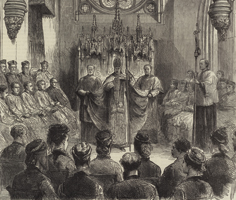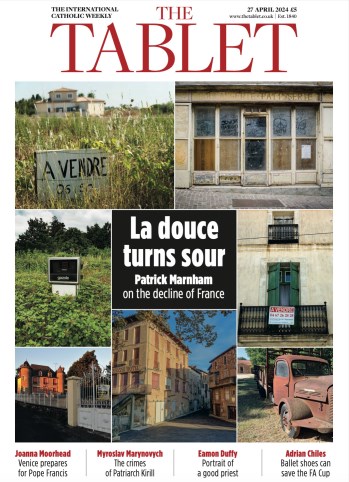2015 marks the 175th anniversary of The Tablet, which has stayed the course to become one of the few publications in Britain to be in print continuously since 1840. And, as its current editor shows, it has always been proud of its Catholic identity
It is hard to imagine today the world in which The Tablet emerged 175 years ago, a world where Catholics in Britain had been until very recently loathed, where popery had been reviled, and where Catholicism had few allies. By 1840 Britain was a nation in flux, where signs of change were evident.
Just how great a change had happened in only a few years can be deduced in the depths of Apsley House, the home of the Duke of Wellington. As would befit one of Britain’s greatest heroes, there is an array of gold, silver, medals, trophies, awards and priceless art – all gifts and honours given to the man who saved the nation and other parts of Europe from Napoleon.
This year Wellington’s triumph over Napoleon at Waterloo 200 years ago will be celebrated. But in the basement of Apsley House is an account of another of Wellington’s great battles, told through a series of remarkable satirical cartoons: of how Catholics were brought in from the cold, and how their champion, Wellington, took on over the issue the very king that he had served on the battlefield.
For more than 200 years, from the accession of Elizabeth I in 1558 to the Catholic Relief Act of 1791, even to attend Mass was illegal. It was forbidden to build Catholic churches and Catholics were persecuted for their faith. The act of 1791 did permit the construction of churches so long as there were no bells and steeples (a ban kept in force until 1926) and the numbers of Catholics rose dramatically, yet still the suspicion of popery and a foreign, alien faith continued.
Catholics were excluded from both Houses of Parliament, from joining the professions and the civil service, and from attending university. The iniquity of the situation was highlighted by the 1828 landslide by-election of Daniel O’Connell, an Irish Catholic, yet he was not legally entitled to sit in the Commons.
Wellington, himself Anglo-Irish, and then serving as Tory Prime Minister, became convinced that only repeal of these discriminatory laws could save the two countries from war. His conviction left him and Robert Peel, the Home Secretary, ranged against the king, George IV, who saw any giving way as a threat to the primacy of the Church of England. Something of the flavour of the times is evident in one of Apsley House’s cartoons: it shows Wellington in monk’s habit and bearing a rosary, as he and the Earl of Winchilsea, one of Catholicism’s most trenchant enemies, fought a duel.
Tensions between King and Prime Minister continued over the place of Catholics and on 4 March 1829, during a meeting between George IV and the Cabinet, with the monarch refusing to give way over Catholic emancipation, Wellington resigned. Only the intervention of a confidante of both the king and Wellington led to the eventual agreement that Catholic emancipation could go ahead.
Not that emancipation wiped out the general prejudices of the population. The Liverpool Mail in July 1851, for example, claimed of Irish migrants that “Popery has so completely polluted their mental faculties and debased the physical and moral habits of the Irish peasant that it is impossible to ameliorate his condition as a social animal”.
The situation regarding the Irish, both as migrants and as people under British rule in their own land, was an issue that dominated the thinking of The Tablet from its first edition of 16 May 1840. In a front-page article it referred to it and to the political status quo:
“We believe there is very little difference between Lord John Russell and Sir Robert Peel in the desire to maintain the present, or very nearly the present, mixture of aristocracy and democracy; the present mode of exercising the prerogative of the Crown; the present mode of administering and amending the laws; and, in short, the present distribution of political, legislative, and administrative power. Both of them, like almost all our statesmen of any political influence, are attached to the Anglican establishment, and are desirous to maintain it in a certain degree of pre-eminence over the Catholic Church, and the sects which the Establishment has brought forth; and both, we believe, are unwilling to accomplish this end, by injuring or insulting those who differ from them in opinion on religious matters.”
The Tablet emerged at a time when Christianity was shifting and changing in Britain: the 1851 census of religious worship showed that around 40 per cent of people attended a church service – perhaps not as many as we would assume. The Anglican response was to make access easier by building more churches in newly industrialised towns and cities.
Nonconformism was growing too, and alongside these new places of worship Catholic ones were constructed as well. During the first decade of The Tablet the Catholic Church in England and Wales was presided over by four Vicars-Apostolic with missionary bishops directly responsible to the Holy See, as had been the arrangement since the time of James II. There was no proper structure of parishes or priests.
Then in 1850, the journal recorded the restoration of the hierarchy, with 12 bishops and an archbishop. Bit by bit, The Tablet described how the life of Catholic Britain grew to be what is today: a comprehensive structure of parishes, a school system, a pyramid of people, priests and bishops.
Since 1840, it has also recorded, described and analysed a global Catholic Church overseen by 13 popes and countless cardinals, including 12 in England alone. There has been the waxing and waning of various movements in the Church, from the first whiff of change in the papacy at the time of Pio Nono, to the nouvelle théologie of Yves Congar and Henri de Lubac, leading to Vatican II, the reforming pontificates of John XXIII and Francis, the warrior pope John Paul II and the studious intellectual Benedict XVI.
There has been the ebb and flow of liturgical practices from old rite to the new vernacular and then to controversial adjustments in the past decade. Liturgy above all has raised the passions of Tablet readers over the years with just one contender exciting our audience almost as much: sex, from contraception and abortion, marriage and divorce, homosexuality and the legalising of gay relationships regularly dominating our pages.
The Tablet staked its reputation with an historic leader at the time of Humanae Vitae in 1968 when it criticised Paul VI’s encyclical banning the use of artificial contraception. Under editor Tom Burns, the paper warned in its edition of 3 August 1968 of the dire consequences of the casuistry and sophistry of some of the encyclical, and set the tone for The Tablet’s continuing loyal, yet critical, approach to the Church:
“Loyalty to the faith and to the whole principle of authority now consists in this: to speak out about this disillusion of ours, not to be silenced by fear. We who are of the household and can think of no other have the right to question, complain and protest, when conscience impels. We have the right and we have the duty – out of love for the brethren. Quis nos separabit?”
A Christian denomination that was once banned, loathed, persecuted and discriminated against has come a very long way in 175 years. During that time The Tablet has reported on radical progress. Neither the opponents of Catholicism’s revival nor The Tablet’s first editor, the Quaker convert Frederick Lucas, could ever have imagined the events that we have covered in our pages since: the visits of two Popes to Britain, the ecumenical friendships that have developed between different Christian denominations. In other words, the tolerance of recent times.
But Lucas would have been no doubt shocked, too, by the horrors recorded, such as the martyrdoms of Oscar Romero, the Jesuits of Algeria, Sr Dorothy Stang, and the scandal of sexual abuse of children by priests and the cover-ups, by the re-emergence of Islamic fundamentalism and Christian persecution.
Perhaps early Tablet editors would have been less surprised by some of the secrecy the Church retains and its, at times, touchy relationship with the press. But The Tablet has always maintained the need to tell its readers the truth about the Church. It must always be mindful of the needs of the pilgrim people of God.
It has been proud, too, to report on the consistent, dogged faith of individuals, the comfort of their belief and the inspiration it brings. And there have been the achievements too: in recent years, Catholics have headed the civil service, been at the top of the BBC, run big businesses, without any prejudice shown against them.
In that sense, Catholics have become part of the Establishment. But they remain outside too, as they did when the early cardinals of the revived hierarchy, including Manning and Vaughan, spoke up and took action on behalf of the migrant poor, of children in need of education, for the dockworkers. That tradition has continued in our time, from Cardinal Hume on the homeless, through Cardinal Cormac Murphy-O’Connor on migrants, to Cardinal Nichols speaking up against human trafficking.
As never before, God’s people are on the move through history, as Lumen Gentium described it. The Tablet has tracked that journey through its pages for 175 years and more recently also through other forms of media, as befits a publication of the twenty-first century. In the coming months we will look back on the milestones on the way in a series of special articles. Be assured that we will continue to be part of the great conversation about the Catholic Church, about faith, and about humanity. We look forward to you joining in that conversation too.





 Loading ...
Loading ...
What do you think?
You can post as a subscriber user...
User Comments (0)